President's Message
In 2015 HCHS will celebrate its 40th anniversary.
We are very saddened by the passing of three HCHS Charter members: Dudley Lanthrip, Roberta Carlton, and Arline Lorente Dowdy.
Dudley Lantrip served as Treasurer for many years and he and his wife Sandy always represented the Society at Varina Day which is held the first weekend of June every year. Sandy also served on the HCHS Executive Board as Chair of the Ways and Means Committee. Both of them have been dedicated members. Even when Dudley was critically ill, Sandy thought to call and say he was unable to be there this year.
Roberta Carlton or Peggy, as she was called, was a founding and charter member of the Varina Women's Club. The Varina Woman's Club was instrumental in creating the Henrico County Historical Society in 1975 as part of the planning for the Henrico observance of the bicentennial celebration of the Declaration of Independence which established the United States of America during the American Revolution. Mrs. Carlton and her husband, Weldon, became charter members of HCHS at that time. She never forgot the close association between HCHS and the Varina Woman's Club and arranged for the VWC to host the Society frequently for the HCHS annual meeting in June.
Arline Lorente Dowdy served as Vice President of the Society for many years. Always promoting the history of Henrico County, Arline did genealogical research on behalf of HCHS. Whenever she was called upon to represent HCHS, she gladly volunteered her time.
Our charter members have been with us for almost 40 years. We would like to dedicate the upcoming anniversary year to those who built the foundation from which we work and to those of you who will carry on the important job of preserving and promoting Henrico County history.
Sarah Pace
President
>Back to Top<
Mark Your Calendar to Learn About Powhatan's Seat of Power

December 7 Meeting
Henrico Theatre
Dr. E. Randolph (Randy) Turner, III will speak on the archaeological discovery of Werowocomoco, the seat of power of Paramount Chief Powhatan.
>Back to Top<
June 1st Attendees Hear About Captain Thomas Harris

Jim Harris addresses the Henrico County Historical Society at its June meeting at the Eastern Recreation Center. Mr. Harris spoke of his ancestor, Captain Thomas Harris, one of the original settlers of Henrico and one of the original owners of Curles Neck.
>Back to Top<
Relive the Richmond Campaign of 1864 at the Reenactment of the Battle of New Market Heights
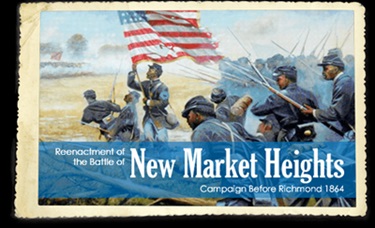
Photo courtesy of http://visithenrico.com.
September 27-28, 2014
Runnymede
8750 Willis Church Road
Henrico, VA 23231
Schedule of Events
Thursday: Sutler registration 8 a.m. - 10 p.m.
Friday: Special education programs. Reenactor registration: 8 a.m. - 10 p.m.
Saturday: 9 a.m. - 6 p.m; Battles at 11 a.m. and 3 p.m. Reenactor registration: 8 a.m. - 5 p.m.
Sunday: 9 a.m. - 3 p.m.; Battle at 1 p.m.
Admission: Admission to all reenactment events is free.
Parking: Parking is free. Shuttle bus transportation is required from parking to event location. Shuttle buses begin at 9 a.m. on both Saturday and Sunday. The last shuttles run at gate closing time.
>Back to Top<
Dr. I. J. Hawkes, a Man of Many Interests and Endeavors, Tries Plunging into Watery Endeavors
Isaiah Jones Hawkes definitely found something in the water in Henrico County–at least in the water at Como Lithia Springs in the county's east end. Among his business ventures was the bottling and marketing of the water and his plans for developing a resort on the site to share its restorative properties with visitors.
Born September 28, 1830, in Hallowell, Maine, Hawkes married Mary W. Magoon in Lynn, Massachusetts, in 1850, lived in Kennebec, Maine, until 1860, then was licensed to practice medicine in Canada. At some point, he lost his wife and married his second wife, Elvira from Ohio. And by 1870, they had come to Virginia and settled at Walnut Lodge on land between the Masonic Home on Nine Mile Road and the railroad lines. Gillie's Creek ran just below the property, but the water that interested him sprang from one of the springs on the land.
Hawkes, however, did not act on that interest for twenty years, waiting until the 1890s to begin marketing Lake Como Springs Lithia Water. During those two decades and afterward, Dr. Hawkes involved himself in his medical practice and entered a number of other enterprises, becoming a prominent member of the greater Richmond community.
That prominence led to his appointment to various offices. For example, The Times-Dispatch of July 2, 1880, recounts Dr. Hawkes' appointment by the court to examine the condition of the Williamsburg turnpike, and his inspection resulted in a report that "the pike was not in good condition." The following year, he was appointed revenue inspector at the port of Richmond to fill the vacancy created by the resignation of Captain B. C. Cook (Daily Dispatch, February 2, 1881).
Additionally, he was among the ten gentlemen incorporated in 1888 by the General Assembly under the name of the Richmond City and Seven Pines Railway Company to construct, equip, maintain and operate the street railway. It seems rather ironic that in the preceding year on September 8, the Richmond Dispatch reported that "Dr. Isaiah J. Hawks [sic], a well known resident of East Richmond, met with a serious accident on Saturday afternoon. . . The Doctor . . . was driving his buggy along Oakwood avenue, when Traction Company Car No. 25 collided with his vehicle, causing him to fall there from. The buggy was smashed, and both the Doctor and his horse were dragged some distance."
Apparently active in the financial world, Dr. Hawkes served as a director on the board of the Lincoln National Building Loan Association and continued to serve on the board after the institution changed to the American Home Building and Loan Association in 1894. The banking world was an interesting contrast to an earlier endeavor referred to in an advertisement in the April 13, 1884 issue of the Times-Dispatch, in which I. J. Hawkes of Walnut Lodge announced the availability of fruit, shade and evergreen trees, roses, grapevines and more from the "Nursery and Greenhouses on the Nine-Mile road, one and one-fourth miles east of the city." He also announced his desire to employ men to sell the nursery stock.
The last part of the decade meant a loss, a move and a beginning for Dr. Hawkes. In 1889, Elvira died, and her funeral took place at Walnut Lodge, which the Times-Dispatch referred to as "the beautiful home of Dr. Hawkes, in East Richmond" (March 13, 1989). The funeral notice went on to note, "There were not many dry eyes, for each throbbed with heartfelt sympathy. A tender love and reverence pervaded the whole scene, and a crowded assembly of well-known people spoke plainly of the high esteem for the departed." Whether or not the loss prompted the move is unknown, but the 1890 census shows I. J. Hawkes residing at 1100 East Broad Street in Richmond.
And it seems that around this time, he embarked on the bottling, marketing and selling of Lake Como Springs Lithia Water taken from the spring on the land at Walnut Lodge. He had apparently sold the property to the East Richmond Co.; but the company became insolvent, went into receivership, and the receivers permitted Hawkes to take possession of it with the understanding that he would purchase it. He did so with L. R. Dennis, and the two organized the Como Lithia Water Company. Their headquarters was an office at 427 East Broad, and they sold twelve half gallon bottles of Lake Como Springs Lithia Water for $3.50 and cases of 50 quarts of Carbonized Water for $6.00.
The two were capitalizing on the time's popularity of lithia water as a sort of cure-all with almost unbounded health benefits. They hired Henry Froehling to chemically analyze the water and found that it contained .02857 grains per gallon, a content they touted in an advertising pamphlet by saying, "It is the lightest water known to chemists, and carries, as you can see, more of that rare ingredient (lithia) to the total amount of mineral matter than any other mineral water." This led them to identify the following conditions as "Cures" resulting from using the water: "Kidney and Bladder troubles, Uric Acid, Gout and Rheumatism, Phosphoric Deposits, Inflammation of the Bladder, Dropsical Affections, Brick Dust Deposits, all forms of Dyspepsia, and all ills arising from a Disordered Stomach." An often-run newspaper ad for thewater was headed with the phrase "Why Not Get Well" in bold type.
Drinking the water supposedly had quite salubrious effects, and their pamphlet suggested, "No rule can be laid down for its use. We would say though that it should be drank [sic] freely and several glasses a day, and be sure and drink a glass before breakfast, and also one before retiring." Additionally, it could be used externally, and a Dr. R. C. Flowers of Boston suggested the following: "This water heated to a temperature as hot as the flesh can well bear, and then used for the purpose of bathing the face at night; wet a towel and apply it steaming hot to the flesh, holding it for a minute or two, repeating it several times, then gently drying the skin by applying a soft dry towel, after which cold cream or white vaseline is gently rubbed into the flesh will remove wrinkles, clear the complexion, and make the skin soft and beautiful."
Hawkes estimated that he was taking about 100 gallons a day from the spring, and he and his partner had plans to expand the operation. The pamphlet announced that "The company proposes in the near future to erect a sanitarium and hotel at the Spring, and will equip the buildings with all the modern improvements so as to make it comfortable and attractive for the large number of people living in the extremes of latitude. . . It contains 109 acres of land, about 50 of which are cleared, the remainder in grove and woodland, which will be converted to parks and drives."
But a problem arose in 1893, requiring Hawkes and Dennis to bring suit against W. A. Woodall, a Richmond merchant dealing in house furnishings to whom Hawkes had rented the Walnut Lodge property. Woodall claimed in a letter of October 1, 1892 that alterations in the spring had deprived him of water for his house and farming operations so that he had no water to the house on "at least 20 occasions in the last three months," and concluded the letter stating, "I caution you or any one else not to interfere with the spring or it surroundings under penalty of the law." In May of 1893, Woodall sent a letter denying Hawkes the right to take the water and placed a locked chain across the entrance to the property to deny entrance. Hawkes and Dennis then went to the property, broke the lock to enter the property and got water then went to filed a complaint against Woodall, seeking an injunction to restrain him from interfering with their getting the water.
The lease for Walnut Lodge had an addendum on the back signed by Hawkes and Woodall stating, "It agreed that Dr. I. J. Hawkes is to have the privilege of getting water from the spring provide [sic] it does not interfere with the quantity required by me, J. Woodall. Dr. I. J. Hawkes can at his own expense improve the spring to increase its capacity." However, Woodall claimed it was not part of the original agreement and was misrepresented. The Henrico Chancery Court records provide conflicting testimony from witnesses on each side as to the effect on Woodall's supply of the removal of water from the spring. One interesting aspect of the testimony is the appearance of two witnesses, L. Pemberton and W. C. Pearman. Pemberton's wife and Pearman had both provided testimonials to the salutory effects of the water in Hawkes' advertising pamphlet. The records also provide some information about the financial venture. According to Dennis's responses to questioning, their expenditures to improve the spring and market the water had totaled about $3365.77 at that point.
It is interesting that their complaint also says that "Your complainants have heard that he [Woodall] claims the right to sell the said water, alleging that he can sell it cheaper than they can." Perhaps, this was, at least in part, the cause of the dispute because Woodall's May 10 letter also said, "you have got in one day over 200 gallons and getting more or less near every day selling it at 15c per gallon without any consideration to me." In his testimony, Hawkes said of Woodall, "I believed him to be of a grasping and querulous nature" and that he had on four occasions deducted five dollars from his rent because Woodall kept "annoying me" and that he did this to save trouble any complications which might cause him any inconvenience.
Hawkes' testimony also illustrates a bit of an overstatement by the company. The company's label depicts a high-prowed ship under sail on a large body of water with another ship in the background. When asked to describe the lake on the property, Hawkes said it was about forty feet long, sixteen feet wide and ranged in depth from one inch to six feet–not quite large enough to float a ship, much less two.
At any rate, the court's decree ordered Woodall to pay the plaintiff's costs and upheld their injunction. The company continued to operate, and a May 5, 1895 advertisement in the Times-Dispatch announced that Lake Como Springs would open on May 29 for guests. It followed that information with the capitalized phrase, "PARTICULAR ATTENTION TO INVALIDS."
The success of the sanitarium is not clear, but by the late 1890s, Hawkes was back in residence at Walnut Lodge; and in 1899, at age 69, he married his third wife, Sallie Goddin Sullivan. She was the daughter of Captain Eugene Sullivan, a former Confederate officer, and was Hawkes' junior by forty years. In 1910, the last year of his life, Sallie sent a letter to The American Journal of Clinical Medicine, extolling a treatment regimen that had earlier helped the doctor and asking for advice for his current illness. The letter provided some details about the couple's earliest meeting. She wrote that her parents were among Dr. Hawkes' earliest patients in Virginia, and that he had been called in "through a mistake of one of the servants. . . His charming ways compelled my father to employ him, in spite of the prejudice which my father bore, at the time for a ‘Yankee." He jumped me many and many a time on his shoulder when I was a baby." Over their eleven years, they had three children, making one wonder if Lake Como Lithia Water didn't have some beneficial effects. Isaiah Jones Hawkes died on September 8, 1910 and is buried at Oakwood Cemetery in Richmond.
Joey Boehling
Hyping the H20. To advertise their lithia water, Hawkes and Dennis distributed the pamphlet seen above, containing an analysis of the water, a brief history of the area and a plethora of testimonials from satisfied users.
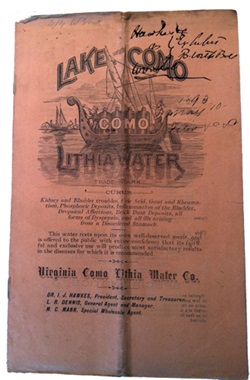
Family portrait. Taken in the last year of his life, this picture shows Dr. Hawkes, his wife Sallie Sullivan Hawkes and their three children.

Good health in a bottle. Above is an embossed Lake Como Lithia Water bottle. Hawkes advertised the water at $3.50 for 12 half gallons.
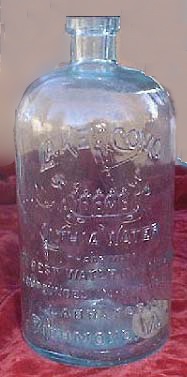
Getting out the word. These two print advertisements appeared often in Richmond newspapers in the 1890s and early 1900s.
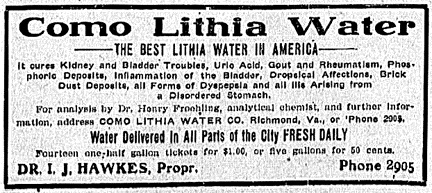

East End estate. This 1901 property map shows the location of Dr. Hawkes' land between the Masonic Home on Nine Mile Road and the York River Railroad. Note that his name is misspelled on the map.
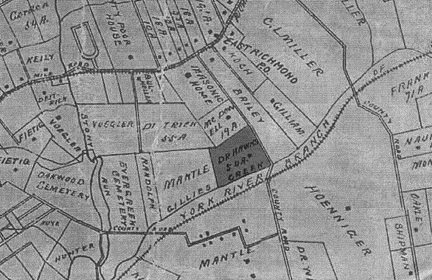
>Back to Top<
Hawkes Connection
Researching the article on Dr. I. J. Hawkes and his lithia water produced an eerie sense of déja vu. Familiar names and places appeared at multiple points along the way, all linked in some way or another with Dr. Hawkes. The Richmond-Henrico area of the nineteenth century seemed so interconnected and such a "small world." Perhaps, it was; or perhaps, Dr. Hawkes' multiple connections was an indication of his local importance. Whatever the reason, we thought it interesting to include a brief journey back through previously HCHS Newsletter articles with some connection to I. J. Hawkes.
March 2008
This issue featured an article on the Seven Pines Railway company, which was chartered as the Richmond City and Seven Pines Railway Company, in 1888. Its single track started at 26th and Q Streets in the city and ran about three blocks then turned and followed Nine Mile Road. It ran fairly close to Dr. Hawkes' land at Walnut Lodge, and he was one of the ten men the General Assembly of Virginia named as Incorporators of the concern. In its final iteration, it became the Sandston Railway.
September 2012
An article about the York family and the Henrico County almshouse mentioned Hugh Davis, who was the superintendent of the facility, located at the Dabbs House near Hawkes' land. When Dr. Hawkes put together his advertising pamphlet, he included the following rather graphic testimonial:
I was a great sufferer from constipation and bleeding piles for a number of years. Como Lithia Water was prescribed by my physician. I used it freely for some weeks. It entirely cured me of these troublesome complaints. I take pleasure in recommending this water to others afflicted as myself."
Hugh L. Davis Superintendent of Henrico County. Almshouse, Va.
December 2013
The story of William Washington Browne, an ex-slave from Georgia, Methodist minister and Grand Worthy Master of the Grand Fountain of the United Order of True Reformers, appeared in this issue. Part of Browne's plans included the erection of an Old Folks Home, and Dr. Hawkes became involved in this–as sort of a victim. A March 16, 1895 issue of the Richmond Planet investigated the shenanigans of a T. W. Porter, who was supposedly raising money for the project but was apparently raising money for himself. Some of that money came from Hawkes, and Porter even used Hawkes' name in his advertising, claiming that Hawkes was the Treasurer bonded for $100,000. Hawkes denied that relationship, and the newspaper went on to say Dr. Hawkes and others were "of the opinion that Mr. Porter was a rascal."
September 2014
Our quarterly meeting is scheduled to take place in the Nature Center at Bryan Park, the former site of Rosewood, the Mordecai family farm. John Mordecai was killed in 1873, in one of the last duels fought in Virginia. It was fought at Walnut Lodge, Dr. Isaiah Jones Hawkes home. It was truly a "small world."
>Back to Top<
Walnut Lodge's Octagon House

Picture courtesy of Virginia Historical Society.
Isaiah J. Hawkes' home at Walnut Lodge was a most unusual structure with an interesting history. It was a sixteen-room two story frame octagon house with a basement and cupola. The two floors had identical floor plans with four large and four small triangular rooms. A wide veranda encircled both floors.
It had been built in 1855 by J. W. Randolph, who lived there until 1866. (Randolph was also called as a witness in the suit mentioned in the Hawkes article to testify about the spring.) According to a report on Walnut Lodge in "Works Progress Administration of Virginia Historical Inventory," "The cupola on the roof was also octagon shaped, as were even the kitchens, stables, gate keepers lodge and the gate posts."
In 1861, General Wade Hampton used it as his headquarters, followed by General Joseph Johnson in 1862, by Robert E. Lee during the Seven Day's Battle and finally by General Eppa Hutton in 1863.
The land was also the site of two rather famous duels. In one Colonel Thomas Smith of Warrenton, son of the governor, and Richard Elam, editor of the Whig, fought over Elam's charge of financial wrongdoing by Governor Smith. Elam took a bullet in the jaw, disfiguring him for life. One of the witnesses to the duel, J. R. Marshall, later married Sallie Sullivan Hawkes' sister.
In 1873, John Mordecai was killed in a duel with W. Page McCarty. A poem McCarty published about Miss Mary Triplett brought about confrontations between the two men, ultimately ending in the duel that took Mordecai's life and crippled McCartyfor life.
Octagon house burned in 1934, when a fire to burn off brush straw grew out of control and destroyed the structure.
Virginia Historical Society
>Back to Top<
Now You Know:
Turning pages Victorian style
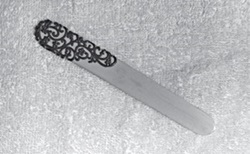
Congratulations to Haywood and Mary Jo Wigglesworth, who correctly identified the last issue's mystery item as a page turner. Victorians, who seemed to have an ornate implement for almost every task, would slide the six-inch ivory and silver filligreed strip under the page of a book and turn it without ever having to touch the page or, heaven forbid, lick a finger to flip it.
There are two more examples of the device shown in the photographs below it. One is wooden with an ornately carved bear head with glass eyes. It is a good deal longer and has a sheath for storage.
The second example is glass with an applied metal grip.


Finally, there is a mechanical page turner for musicians. Sheet music was inserted with the pages between the brass arms; and when the page needed to be turned, the button was pushed - no need to lose one's place in the score.
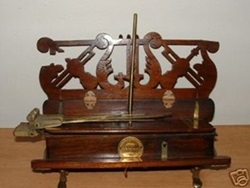
>Back to Top<
What Do You Know?

The tapered cylindrical item pictured below is 3 1/2" long and 2" in diameter at the base. The metal object has a small loop in the indentation at the top and weighs 2 1/2 pounds.
Do you know what it is?
Please email your answer to jboehling@verizon.net.
>Back to Top<
News 2014: Third Quarter
First Quarter | Second Quarter | Fourth Quarter
Home | Henrico | Maps | Genealogy | Preservation | Membership | Shopping | HCHS
|











